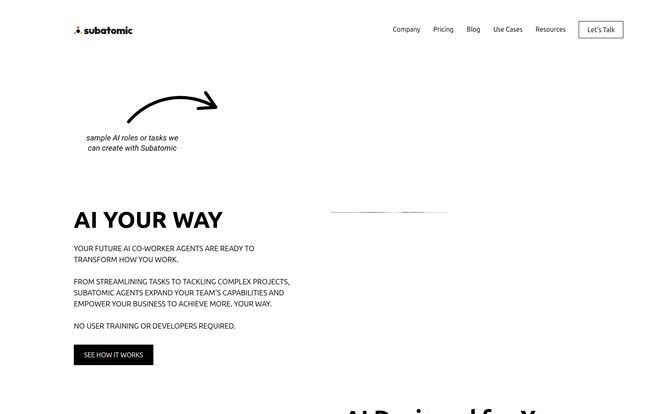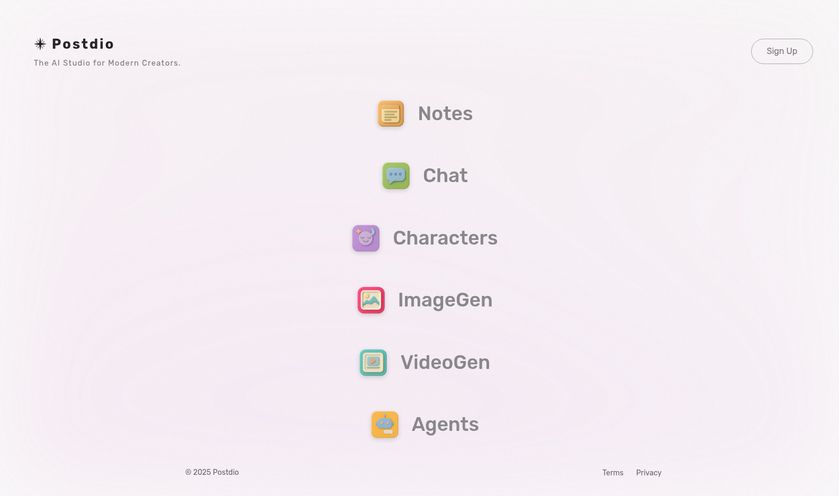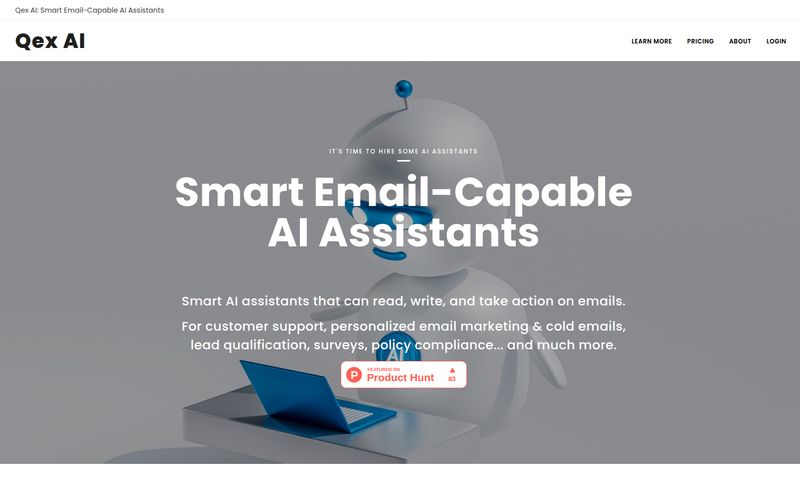The AI hype train is moving at a thousand miles an hour, and most of us are just trying not to get run over. Every single week, there's a new “game-changing” app, another platform promising to 10x your productivity, and yet another login for your team to forget. It's exhausting. I've personally tested more AI writing assistants, image generators, and coding helpers than I can count, and the biggest hurdle is always the same: adoption. Getting your team to actually use the shiny new toy is half the battle.
So when I stumbled upon Subatomic, my initial reaction was a healthy dose of SEO-pro skepticism. Their pitch isn't about giving you a new tool. It’s about giving you a new teammate. An AI Co-Worker, they call it. One that doesn't need its own app or a special login. It just… shows up to work inside the tools you already use. Slack, Google Docs, Microsoft Office, you name it. A bold claim. A very, very bold claim. But one I had to investigate.
What Exactly is a Subatomic AI Co-Worker?
Forget everything you think you know about chatbots or AI assistants. This isn't about opening a separate window to ask a question. Subatomic’s approach is fundamentally different. Imagine you're hiring a new junior employee. You wouldn't just throw them in a room and hope for the best, right? You'd onboard them. You'd teach them your company's voice, your processes, your rules. You’d show them who to report to and how to format their work.
That's the core idea here. A Subatomic AI Co-Worker is a custom-built AI agent that you “onboard” into your business. You train it on your specific needs, policies, and brand guidelines. It then lives and works right alongside your human team in their existing digital environment. It’s less of a tool you operate and more of a digital colleague you delegate tasks to. The most mind-blowing part for me? They claim it requires no user training or developers. The AI adapts to your workflow, not the other way around. Now that got my attention.

Visit Subatomic
More Than Just a Chatbot: Key Features in Action
Okay, so the concept is cool. But what does this AI teammate actually do? I dug into their main use cases, and it’s all about tackling those time-sucking, process-heavy tasks that clog up our workdays.
Automated Document Review That Doesn't Suck
Anyone who's ever had to review a pile of legal agreements, marketing briefs, or compliance reports knows the special kind of soul-crushing boredom it can induce. Subatomic's AI agent can be trained to be your first line of defense. You can teach it to scan documents for specific clauses, check for brand consistency, or flag non-compliant language. It's like having a paralegal or a meticulous proofreader who works 24/7 and never needs a coffee break. The accuracy boost alone could be worth its weight in gold.
Your New Content Creation Assistant
Yes, it can help with content. But again, it's about the integration. Instead of you going to ChatGPT and pasting prompts, your Subatomic agent can be tasked to draft the first version of a blog post, a series of marketing emails, or an internal report, all based on the specific voice and style guide you've trained it on. This is a huge step up from generic AI content. It’s about creating content that sounds like your company from the get-go, not a watered-down robot imitation.
True Collaboration, Right Inside Slack and Office
This is the killer feature, in my opinion. The ability to collaborate with the AI without leaving your workflow is a game-changer. Imagine being in a Slack channel and just typing "@AI-Steve, can you summarize this conversation and create action items?" or working in a Google Doc and highlighting a section to ask the agent to expand on it. This removes the friction. It makes using AI a natural extension of the work, not a separate, clunky step. No more copy-pasting between ten different browser tabs. A small change, but a profound one for day-to-day productivity.
The Onboarding Process: It's Like Hiring a Human (Almost)
Subatomic frames their setup as a four-step onboarding process, and having managed teams for years, it felt weirdly familiar. It’s not an instant plug-and-play solution, and that's actually a good thing. It’s a considered process.
- Define Your Team's Needs: This is like writing the job description. What specific, repetitive task do you want to offload? Is it reviewing support tickets, drafting social media posts, or checking code for errors? You have to be specific.
- Customize Your AI Co-Worker: Here's where you define its skills and personality. You feed it your brand guidelines, your data sources, and your expected outcomes. It's the training and orientation phase.
- Onboard Your Team of AI Co-Workers: You introduce the agent to your team and set it up within your chosen platforms, like Slack or Figma.
- Integrate with Your Workflows: This is where the magic happens. The agent starts performing its tasks, and your team starts collaborating with it as if it were just another person on the project.
Let's Talk Brass Tacks: Subatomic Pricing
Alright, the million-dollar question. How much does this digital teammate cost? If you're looking for a simple pricing page with three tiers and a credit card form, you're out of luck. Subatomic has a customized pricing model, which is common for B2B SaaS platforms targeting larger, more complex organizations. You have to talk to them to get a quote.
They offer two main plans to get started:
| Plan | Best For | Key Features |
|---|---|---|
| Paid Pilot | Organizations that need to test the waters and get internal buy-in before a full rollout. | Price based on scope, select features, limited workflows, customizable UI. |
| Business Plan | Organizations ready to fully deploy AI Co-Workers across teams and departments. | Annual pricing, access to all features, advanced model tuning, full integrations. |
My take? The Pilot is for proving the concept to your CFO. The Business Plan is for when you're ready to make AI a core part of your operations.
The Good, The Bad, and The AI
No tool is perfect, not even a digital human. After digging in, here's my breakdown of the highs and potential lows. The best thing, hands down, is the seamless integration. The fact that my team wouldn't need a single training session is a massive, massive win. Productivity and accuracy gains seem almost inevitable when you remove tedious work from peoples plates. And the ability to scale, adding more specialized agents as you grow, is incredibly appealing.
However, there are some things to consider. This isn't a magic wand. The "customization" required means you need to invest time upfront to define the processes and train the agent properly. Garbage in, garbage out, as they say. You're also putting a lot of faith in one platform for this functionality. And while they talk a big game about security—mentioning SOC2, GDPR, and HIPAA compliance—handing over sensitive company data to any third-party AI always gives me a slight pause. It requires a lot of trust and a careful look at their data policies.
Who Is Subatomic Actually For?
So, who should be booking a demo? In my professional opinion, Subatomic is not for the solopreneur or the small five-person startup just looking for a cheap way to write blog posts. This is a serious tool for serious operations.
I see this being a home run for mid-to-large-sized companies, particularly in departments drowning in process. Think legal teams reviewing contracts, marketing teams managing multi-channel campaigns, or HR departments sifting through resumes. It's for organizations that are mature enough to have established workflows but maybe lack the in-house developer resources to build their own bespoke AI solutions. It hits a very specific, and very important, sweet spot in the market.
Final Thoughts: Is This the Future of the Digital Workplace?
I've seen a lot of AI tools come and go. Most are just features, a temporary boost. Subatomic feels different. It feels like a shift in strategy. The move away from 'using AI tools' and toward 'collaborating with AI teammates' might just be the evolution we've been waiting for. It reframes the entire human-computer interaction into something more natural, more integrated, and ultimately, more powerful.
It’s not about replacing humans, but augmenting them by taking away the robotic parts of their jobs so they can focus on the creative, strategic thinking that people do best. Is Subatomic the one to pull it off for everyone? Time will tell. But they are asking the right questions and building something that feels less like another piece of software and more like the future of work. And for the first time in a while when it comes to a new AI platform, I'm genuinely excited to see what happens next.
Frequently Asked Questions about Subatomic
What's the real difference between the Pilot and Business plans?
Think of the Paid Pilot as a focused trial run. It's designed to prove the ROI on a specific task or within a single team. The Business Plan is the full-scale deployment, offering access to all of Subatomic's features, deeper integrations, and advanced model tuning for higher performance across your entire organization.
Is there a free trial available?
Based on their model, it's unlikely there's a traditional 'free trial'. The "Paid Pilot" serves as the entry point for testing the platform. This model is common for high-touch, enterprise-grade software that requires significant setup and customization.
How long does it really take to set up an AI Co-Worker?
This will vary wildly based on the complexity of the task. A simple agent to summarize Slack channels might be set up relatively quickly. A more complex one for reviewing legal documents with dozens of criteria will require a more intensive 'onboarding' process where you provide more data and examples.
Is my company's data safe with Subatomic?
Subatomic states that its platform is built to be secure and compliant with major standards like SOC2, GDPR, and HIPAA. However, as with any third-party tool, you should always conduct your own due diligence and review their specific data handling and privacy policies before feeding it sensitive information.
Can the AI agent really work inside any tool?
Their site specifically mentions common collaboration hubs like Slack, Google Docs, Microsoft Office, and Figma. The idea is to integrate where your team already works. For more niche or proprietary software, you would need to discuss the integration possibilities directly with their team during the sales process.
Reference and Sources
- Subatomic Official Website
- Forbes Article on AI Agents in the Workplace
- Information on SOC 2 Compliance



